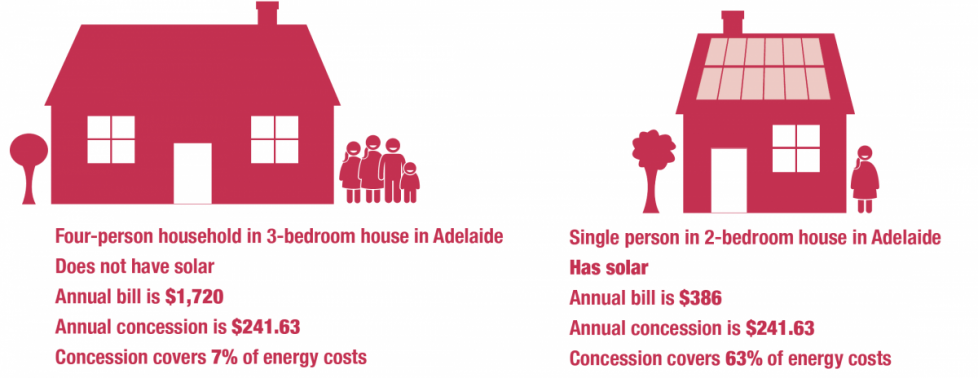Reforming electricity concessions to better meet need
SACOSS has long been calling for energy concessions reform, and in 2020, received funding from Energy Consumers Australia (ECA) to lead a national research project with the Australian Council of Social Service (ACOSS) to better understand the flaws and inequities in existing concessions schemes and propose a new approach that better meets households' needs.
Like the majority of state and territory governments, the South Australian Government provides energy concessions for people living on very low incomes as a fixed amount (flat-rate). Research conducted by Alviss Consulting for the project, found that providing energy concessions as a fixed amount means it does not respond to energy price changes, seasonal variations in energy use, or the energy performance of the home. It also means that some people are getting more assistance than they need, and others are getting significantly less.
For example, a fixed concession of $241.63 a year would only cover 7% of the energy bill of a 4-person family in a 3-bedroom home without solar, compared to a single person 2-bedroom home with solar where the same concession covers 63% of the energy bill.

The report recommends shifting to a percentage-based concession (such as the model currently operating in Victoria) which will help adapt support relative to need and circumstances, changes in the energy market and technology, and help manage the risks of the energy market transition for those most in need.
The report also considers transitional arrangements and notes that investment in energy efficiency, electrification and solar for low-income homes, combined with percentage-based concession, would ultimately reduce the cost to governments as well as households.
What SACOSS is calling for
SACOSS, along with a coalition of social service organisations, are calling for the following commitments to address the systemic flaws in concessions:
- Ensure energy concessions better meet needs
-
1. As part of the National Energy Transformation Partnership, Energy Ministers commit to working with Social Service Ministers, to undertake energy concessions reform appropriate to their jurisdictions to better meet people’s energy needs and changing circumstances.
- Ensure energy concessions are adequate, equitable and responsive
-
2. Energy Ministers should request the ACCC to model how percentage-based (or hybrid-based) energy concessions can be implemented across all jurisdictions. The analysis should be done within 6 months and include:
a. What quantum (%) is required to better meet need
b. Ability to meet changing circumstances (including current and future price shocks)
c. Possible transitional arrangements and complementary measures (including grandfathering, energy efficiency and solar retrofits, and other additional support needed by households unable to access solar).
d. Impacts on low-income households types of a,b and c.
e. Impact on government budget of a, b and c.
- Ensure people in need of energy concessions are eligible and can access them
-
3. Energy Ministers should work with Social Services Ministers to review and reform eligibility for energy concessions to ensure the inclusion of all people who need additional financial support to access enough energy to support health and wellbeing. The review should include consultation with the community.
4. Energy Ministers should work with Social Service Ministers and relevant regulators to ensure people who are eligible for energy concessions receive them, including using automation in relevant systems and awareness raising programs.
In addition to the above, there are preventive and complementary measures which federal and state governments can implement to prevent reliance on energy concessions.
Government investment in thermal improvements, upgrading to more efficient appliances, and installing rooftop solar for low-income homes (including rentals and apartments) will reduce household energy usage and costs. Combined with a percentage-based concession there would be a long-term reduction in government expenditure on energy concessions, as well as ancillary benefits to health budgets.
- Complementary measures to support the effectiveness of energy concessions
-
5. The Federal Government should immediately lift income support to improve the capacity of people on low incomes to manage energy bills, including increasing Jobseeker and related allowances above the poverty line.
6. The Federal, State and Territory governments should co-invest in efficient electric appliances, thermal efficiency and solar upgrade programs for low-income homes.
7. The Federal, State and Territory governments should shift the costs of green schemes off bills or offset the costs for people on low incomes.
The rationales and details for these specific proposals are set out in the Summary Report, which can be accessed below.
More Information
Reports and workbook
Reforming electricity concessions to better meet need: Summary Report
Assessing impacts of changes to Australian electricity concessions - Interim Report and Concessions Modelling Workbook
Assessing impacts of changes to Australian electricity concessions - Final Report
Media
